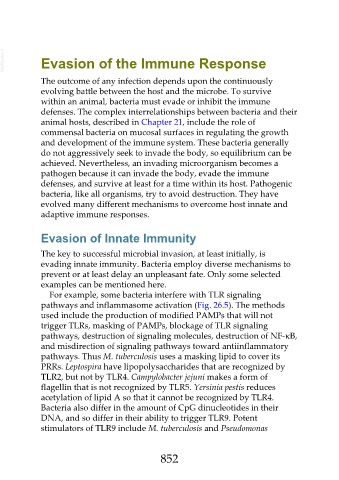Page 852 - Veterinary Immunology, 10th Edition
P. 852
VetBooks.ir Evasion of the Immune Response
The outcome of any infection depends upon the continuously
evolving battle between the host and the microbe. To survive
within an animal, bacteria must evade or inhibit the immune
defenses. The complex interrelationships between bacteria and their
animal hosts, described in Chapter 21, include the role of
commensal bacteria on mucosal surfaces in regulating the growth
and development of the immune system. These bacteria generally
do not aggressively seek to invade the body, so equilibrium can be
achieved. Nevertheless, an invading microorganism becomes a
pathogen because it can invade the body, evade the immune
defenses, and survive at least for a time within its host. Pathogenic
bacteria, like all organisms, try to avoid destruction. They have
evolved many different mechanisms to overcome host innate and
adaptive immune responses.
Evasion of Innate Immunity
The key to successful microbial invasion, at least initially, is
evading innate immunity. Bacteria employ diverse mechanisms to
prevent or at least delay an unpleasant fate. Only some selected
examples can be mentioned here.
For example, some bacteria interfere with TLR signaling
pathways and inflammasome activation (Fig. 26.5). The methods
used include the production of modified PAMPs that will not
trigger TLRs, masking of PAMPs, blockage of TLR signaling
pathways, destruction of signaling molecules, destruction of NF-κB,
and misdirection of signaling pathways toward antiinflammatory
pathways. Thus M. tuberculosis uses a masking lipid to cover its
PRRs. Leptospira have lipopolysaccharides that are recognized by
TLR2, but not by TLR4. Campylobacter jejuni makes a form of
flagellin that is not recognized by TLR5. Yersinia pestis reduces
acetylation of lipid A so that it cannot be recognized by TLR4.
Bacteria also differ in the amount of CpG dinucleotides in their
DNA, and so differ in their ability to trigger TLR9. Potent
stimulators of TLR9 include M. tuberculosis and Pseudomonas
852

